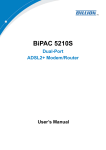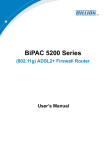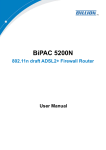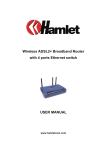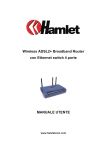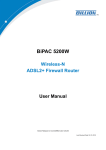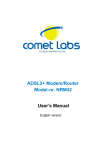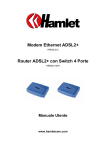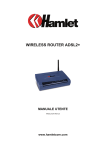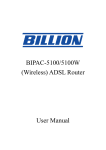Download Billion BiPAC 5200S RC Series User manual
Transcript
BiPAC 5200S RC Series ADSL2+ Modem / Router User Manual Version released: 2.12.17.0(UE2.C3)3.12.17.0 Last revised date: 07-29-2011 Table of Contents Chapter 1 ............................................................................................................................1 1.1 Introducing the BiPAC 5200S RC Series ................................................................1 1.2 Features of the BiPAC 5200S RC Series ................................................................3 1.3 Application for the BiPAC 5200S RC Series...........................................................5 1.3.1 BiPAC 5210S RC ................................................................................................5 1.3.2 BiPAC 5200S RD ................................................................................................5 1.3.3 BiPAC 5200S RC ................................................................................................6 Chapter 2 ............................................................................................................................7 2.1 Important note for using the BiPAC 5200S RC Series...........................................7 2.2 Package Contents ....................................................................................................8 2.3 Hardware Overview ..................................................................................................9 2.3.1 BiPAC 5210S RC ................................................................................................9 2.3.2 BiPAC 5200S RC / BiPAC 5200S RD ............................................................... 11 2.4 Cabling ....................................................................................................................13 Chapter 3 ..........................................................................................................................14 3.1 Before Configuration .............................................................................................14 3.1.1 Configuring PC in Windows 7.........................................................................15 3.1.2 Configuring PC in Windows Vista ..................................................................17 3.1.3 Configuring PC in Windows XP......................................................................19 3.1.4 Configuring PC in Windows 2000...................................................................20 3.1.5 Configuring PC in Windows 98/Me.................................................................21 3.1.6 Configuring PC in Windows NT4.0.................................................................22 3.2 Step-by-Step Installation .......................................................................................23 3.3 Factory Default Settings ........................................................................................29 3.3.1 Username and Password ................................................................................29 3.4 LAN and WAN Port Addresses ..............................................................................30 3.5 Information from your ISP .....................................................................................30 3.6 Configuring with your Web Browser ....................................................................31 Chapter 4 ..........................................................................................................................32 4.1 Quick Start ..............................................................................................................33 i 4.2 Interface Setup .......................................................................................................37 4.2.1 Internet .............................................................................................................38 4.2.2 LAN ...................................................................................................................42 4.3 Advanced Setup .....................................................................................................44 4.3.1 Firewall .............................................................................................................44 4.3.2 Routing .............................................................................................................45 4.3.3 NAT ...................................................................................................................47 4.3.4 ADSL .................................................................................................................54 4.4 Access Management ..............................................................................................55 4.4.1 ACL ...................................................................................................................55 4.4.2 Filter..................................................................................................................56 4.4.3 SNMP ................................................................................................................60 4.4.4 UPnP .................................................................................................................61 4.4.5 DDNS ................................................................................................................62 4.5 Maintenance ...........................................................................................................63 4.5.1 Administration .................................................................................................63 4.5.2 Time Zone.........................................................................................................64 4.5.3 Firmware...........................................................................................................65 4.5.4 SysRestart ........................................................................................................66 4.5.5 Diagnostics ......................................................................................................67 4.6 Status ......................................................................................................................68 4.6.1 Device Info .......................................................................................................68 4.6.2 System Log ......................................................................................................70 4.6.3 Statistics...........................................................................................................71 4.7 Help .........................................................................................................................73 Chapter 5 ..........................................................................................................................74 APPENDIX ........................................................................................................................76 ii Chapter 1 Introduction the BiPAC 5200S RC Series 1.1 Introducing the BiPAC 5200S RC Series Welcome to the Billion BiPAC 5200S RC Series ADSL2+ Modem/Router. Your Billion router is an “all-in-one” unit, combining an ADSL modem, ADSL router and Ethernet network router, providing everything you need to get the machines on your network connected to the Internet over your ADSL broadband connection. The BiPAC 5200S RC Series router complies with ADSL2+ standards for worldwide deployment and supports downstream rate of up to 24 Mbps and upstream rate of up to 1 Mbps. It is designed for small office, home office and residential users, enabling even faster speed Internet connections. User can enjoy ADSL services and broadband multimedia applications such as interactive gaming, video streaming and real-time audio much easier and faster than ever before. The product supports PPPoA (RFC 2364 - PPP (Point-to-Point Protocol) over ATM Adaptation Layer 5), RFC 1483 encapsulation over ATM (bridged or routed), PPP over Ethernet (RFC 2516), and IPoA (RFC1577) to establish a connection with ISP. The product also supports VC-based and LLC-based multiplexing. It is the perfect solution to connect a small group of PCs to a high-speed broadband Internet connection. Multi-users can have high-speed Internet access simultaneously. This product also serves as an Internet firewall, protecting your network from being accessed by outside users. It not only provides the natural firewall function (Network Address Translation, NAT), it also provides rich firewall features to secure user’s network. All incoming data packets are monitored and filtered. Besides, it can also be configured to block internal users from accessing to the Internet. The product provides two levels of security support. First, it makes LAN users’ IP addresses invisible to outside users on the Internet, making it much more difficult for a hacker to target 1 your machine on the network. Second, it can block and redirect certain ports to limit the services that outside users can access. For example, to ensure that games and other Internet applications run properly, user can open some specific ports for outside users to access the internal services of the network. Integrated DHCP (Dynamic Host Control Protocol) services, client and server allow multiple users to get their IP addresses automatically from the product on a boot up. Simply set local machines as a DHCP client to accept a dynamically assigned IP address from the DHCP server. Whenever the local machine is powered up, the router will recognize it and will assign an IP address to connect to the LAN instantly. For advanced users, Virtual Service function allows the product to provide limited visibility to local machines with specific services for outside users. An ISP (Internet Service Providers) provided IP address can be set to the product and then specific services can be rerouted to specific computers on the local network. For instance, a dedicated web server can be connected to the Internet via the product and then incoming requests for HTML that are received by the product can be rerouted to the dedicated local web server, even though the server may already have a different IP address. Thus, the product may be vulnerable to the attack on the Internet, but the server is protected. Virtual Server can also be used to re-task services to multiple servers. For instance, the product can be set to allow separated FTP, Web, and Multiplayer game servers to share the same Internet-visible IP address while still protecting the servers and LAN users from hackers. 2 1.2 Features of the BiPAC 5200S RC Series ADSL Multi-Mode Standard Support downstream rate of up to 24 Mbps and upstream rate of up to 1 Mbps. It also supports rate management that allows ADSL subscribers to select an Internet access speed that suits their needs and budgets. It is compliant with Multi-Mode standard (ANSI T1.413, Issue 2; G.dmt(G.992.1); G.lite(G992.2)), G.hs (G994.1), G.dmt.bis (G.992.3), G.dmt.bisplus (G.992.5)). The Annex A and B are supported in different H/W platforms. Fast Ethernet Router A 10/100Mbps fast Ethernet router is built in with automatic switching between MDI and MDI-X for 10Base-T and 100Base-TX ports. An Ethernet straight or cross-over cable can be used directly for auto detection. Multi-Protocol to Establish A Connection Support PPPoA (RFC 2364 - PPP over ATM Adaptation Layer 5), RFC 1483 encapsulation over ATM (bridged or routed), PPP over Ethernet (RFC 2516) and IPoA (RFC1577) to establish a connection with the ISP. The product also supports VC-based and LLC-based multiplexing. Quick Installation Wizard Support a WEB GUI page to install this device quickly. With this wizard, end users not only can enter the information is provided by their ISP easily, this feature also makes immediate internet surfing possible. Universal Plug and Play (UPnP) and UPnP NAT Traversal This protocol is used to enable simple and robust connectivity among stand-alone devices and PCs from many different vendors. It makes networking simple and affordable for users. UPnP architecture leverages the advantages of TCP/IP and the Web to enable seamless proximity networking in addition to controlling data transfer among networked devices. With this feature enabled, users can now connect to Net meeting or MSN Messenger seamlessly. Network Address Translation (NAT) Allow multi-users to access outside resources such as the Internet simultaneously with one IP address/one Internet access account. Support a huge variety of application layer gateways (ALG) are such as web browser, ICQ, FTP, Telnet, E-mail, News, Net2phone, Ping, NetMeeting, IP phone and others. Firewall Support simple firewall with NAT technology and provide option for blocking access from Internet, like Telnet, FTP, WEB, SNMP and IGMP. Domain Name System (DNS) relay 3 Provide an easy way to map the domain name (a friendly name for users such as www.yahoo.com) and IP address. When a local machine sets its DNS server with this router IP address, every DNS conversion request packet from the PC to this router will be forwarded to the real DNS of the outside network. Dynamic Domain Name System (DDNS) The Dynamic DNS service allows you to alias a dynamic IP address to a static hostname. This dynamic IP address is the WAN IP address. For example, to use the service, you must first apply for an account from a DDNS service like http://www.dyndns.org/. PPP over Ethernet (PPPoE) Provide embedded PPPoE client function to establish a connection. Users can get greater access speed without changing the operation concept, sharing the same ISP account and paying for one access account. No PPPoE client software is required for local computer. The Automatic Reconnect and Disconnect Timeout (Idle Timer) functions are provided, too. Virtual Server User can specify some services to be visible to outside users. The router can detect incoming service request and forward it to a specific local computer for task handling. For example, user can assign a PC in the LAN to act as a WEB server inside and expose it to the outside network. Outside user can browse inside the web server directly while still being protected by NAT. A DMZ host setting is also provided to a local computer being exposed to the outside network, Internet. Dynamic Host Configuration Protocol (DHCP) client and server In the WAN site, the DHCP client can get an IP address from the Internet Service Provider (ISP) automatically. In the LAN site, the DHCP server can allocate a range of client IP addresses including IP address; subnet mask as well as DNS IP address and distribute them to local computers. It provides an easy way to manage the local IP network. RIP1/2 Routing Support RIP1/2 routing protocol for routing capability. Simple Network Management Protocol (SNMP) It is an easy way to remotely manage the router via SNMP. Web based GUI Support web based GUI for configuration and management. It is user-friendly and come with on-line help. It also supports remote management capability for remote users to configure and manage this product. Firmware Upgradeable Device can be upgraded to the latest firmware through the WEB based GUI. 4 1.3 Application for the BiPAC 5200S RC Series 1.3.1 BiPAC 5210S RC 1.3.2 BiPAC 5200S RD 5 1.3.3 BiPAC 5200S RC 6 Chapter 2 Installing the BiPAC 5200S RC Series 2.1 Important note for using the BiPAC 5200S RC Series Warning 9 Do not use the BiPAC 5200S RC Series device in high humidity or high temperatures. 9 Do not use the same power source for the BiPAC 5200S RC Series as other equipment. 9 Do not open or repair the case yourself. If the BiPAC 5200S RC device is too hot, turn off the power immediately and have it repaired at a qualified service center. Avoid using this product and all accessories outdoors. 9 9 Place the BiPAC 5200S RC Series device on a stable surface. 9 Only use the power adapter that comes with the package. Using a different voltage rating power adaptor may damage the router. Attention 7 2.2 Package Contents BiPAC 5210S RC / 5200S RC / 5200S RD ADSL2+ Modem/Router CD-ROM containing the online manual RJ-11 ADSL/telephone Cable Ethernet (CAT-5 LAN) Cable USB Cable (For BiPAC 5210S RC only) Power adapter Quick Start Guide 8 2.3 Hardware Overview 2.3.1 BiPAC 5210S RC Front LEDs LED Meaning Lit red when power is ON. Lit green when the system is ready. Lit when connected to an Ethernet device. Lit green for both 10M and 100M. Blinking when data is Transmitted / Received. 1 Power 2 Ethernet 3 USB Lit green when the router is connected to a USB device. Flash when data is received / transmitted. 4 DSL Lit green steadily when successfully connected to an ADSL DSLAM (“linesync”). 5 Internet Lit red when WAN fails to get IP address. Lit green when WAN gets the IP address successfully. 9 Rear Panel Port Meaning 1 DSL Connect the supplied RJ-11 (“telephone”) cable to this port when connecting to the ADSL/telephone network. 2 USB Connect the USB cable to this port. Connect to a UTP Ethernet cable (Cat-5 or Cat-5e) to the Ethernet port when connecting to a PC or an office/home network of 10Mbps or 100Mbps. After the device is powered on, press it to reset the device or restore to factory default settings. 1-3 seconds: reset the device 6 seconds above: restore to factory default settings (this is used when you cannot login to the router, e.g. forgot the password) 3 Ethernet 4 Reset 5 Power Connect the supplied power adapter to this jack. 6 Power Switch Power ON/OFF switch. 10 2.3.2 BiPAC 5200S RC / BiPAC 5200S RD Front LEDs LED 1 Power 2 Ethernet 3 DSL 4 Internet Meaning Lit red when power is ON. Lit green when the system is ready. Lit when connected to an Ethernet device. Lit green for both 10M and 100M. Blinking when data is Transmitted / Received. Lit green steadily when successfully connected to an ADSL DSLAM (“linesync”). Lit red when WAN fails to get IP address. Lit green when WAN gets the IP address. 11 Rear Panel Port Meaning Connect the supplied RJ-11 (“telephone”) cable to this port when connecting to the ADSL/telephone network. Connect a UTP Ethernet cable (Cat-5 or Cat-5e) to the Ethernet port when connecting to a PC or an office/home network of 10Mbps or 100Mbps. After the device is powered on, press it to reset the device or restore to factory default settings. 1-3 seconds: reset the device 6 seconds above: restore to factory default settings (this is used when you cannot login to the router, e.g. forgot the password) 1 DSL 2 Ethernet 3 Reset 4 Power 5 Power Switch (Only for 5200S Power ON/OFF switch. RD) Connect the supplied power adapter to this jack. 12 2.4 Cabling One of the most common problems is due to bad cabling or ADSL line(s). Make sure that all connected devices are turned on. On the front panel of the product is a row of LEDs. Verify that the LAN Links and ADSL line LEDs are lit. If they are not, verify that you are using the proper cables. Ensure that all other devices connected to the same telephone line as your Billion router (e.g. telephones, fax machines, analogue modems) have a line filter connected between them and the wall socket (unless you are using a Central Splitter or Central Filter installed by a qualified and licensed electrician), and ensure that all line filters are correctly installed and the right way around. Missing line filters or line filters installed the wrong way around can cause problems with your ADSL connection, including frequent disconnections. 13 Chapter 3 Basic Installation The router can be configured with your web browser. A web browser is included as a standard application in the following operating systems: Windows 7/98 / NT / 2000 / XP /Me/Vista, MAC, Linux, etc. The product provides a very easy and user-friendly interface for configuration. 3.1 Before Configuration PCs must have an Ethernet interface installed properly and be connected either to the router directly or through an external repeater hub. It must also have the TCP/IP installed and configured to obtain an IP address through a DHCP server or a fixed IP address that must be in the same subnet as the router. The default IP address of the router is 192.168.1.254 and the subnet mask is 255.255.255.0 (i.e. any attached PC must be in the same subnet, and have an IP address in the range of 192.168.1.1 to 192.168.1.253). The best and easiest way is to configure the PC to get an IP address automatically from the router using DHCP. If you encounter any problem accessing the router’s web interface it may also be advisable to uninstall any kind of software firewall on your PCs, as they can cause problem accessing the 192.168.1.254 IP address of the router. Users should make their own decision on how to best protect their networks. Please follow the steps below /for your PC’s network environment installation. First check your PC’s network components. The TCP/IP protocol stack and Ethernet network adapter must be installed. If not, please refer to your Windows-related or other operating system manuals. 14 3.1.1 Configuring PC in Windows 7 1. Go to Start. Click on Control Panel. 2. Then click on Network and Internet. 3. When the Network and Sharing Center window pops up, select and click on Change adapter settings on the left window panel. 4. Select the Local Area Connection, and right click the icon to select Properties. 15 5. Select Internet Protocol Version 4 (TCP/IPv4) then click Properties. 6. In the TCP/IPv4 properties window, select the Obtain an IP address automatically and Obtain DNS Server address automatically radio buttons. Then click OK to exit the setting. 7. Click OK again in the Local Area Connection Properties window to apply the new configuration. 16 3.1.2 Configuring PC in Windows Vista 1. 2. Go to Start. Click on Network. Then click on Network and Sharing Center at the top bar. 3. When the Network and Sharing Center window pops up, select and click on Manage network connections on the left window column. 4. Select the Local Area Connection, and right click the icon to select Properties. 17 5. Select Internet Protocol Version 4 (TCP/IPv4) then click Properties. 6. In the TCP/IPv4 properties window, select the Obtain an IP address automatically and Obtain DNS Server address automatically radio buttons. Then click OK to exit the setting. Click OK again in the Local Area Connection Properties window to apply the new configuration. 7. 18 3.1.3 Configuring PC in Windows XP 1. Go to Start / Control Panel (in Classic View). In the Control Panel, double-click on Network Connections 2. Double-click Local Area Connection. 3. In the Local Area Connection Status window, click Properties. 4. Select Internet Protocol (TCP/IP) and click Properties. 5. Select the Obtain an IP address automatically and the Obtain DNS server address automatically radio buttons. 6. Click OK to finish the configuration. 19 3.1.4 Configuring PC in Windows 2000 1. Go to Start / Settings / Control Panel. In the Control Panel, double-click on Network and Dial-up Connections. 2. Double-click Local Area Connection. 3. In the Local Area Connection Status window click Properties. 4. Select Internet Protocol (TCP/IP) and click Properties. 5. Select the Obtain an IP address automatically and the Obtain DNS server address automatically radio buttons. 6. Click OK to finish the configuration. 20 3.1.5 Configuring PC in Windows 98/Me 1. Go to Start / Settings / Control Panel. In the Control Panel, double-click on Network and choose the Configuration tab. 2. Select TCP/IP ->NE2000 Compatible, or the name of your Network Interface Card (NIC) in your PC. 3. Select the Obtain an IP address automatically radio button. 4. Then select the DNS Configuration tab. 5. Select the Disable DNS radio button and click OK to finish the configuration. 21 3.1.6 Configuring PC in Windows NT4.0 1. Go to Start / Settings / Control Panel. In the Control Panel, double-click on Network and choose the Protocols tab. 2. Select TCP/IP Protocol and click Properties. 3. Select the Obtain an IP address from a DHCP server radio button and click OK. 22 3.2 Step-by-Step Installation 1. 2. 3. Insert the CD-ROM into CD-ROM drive Execute Windows Utility The Welcome screen will appear, click Next 4. The Hardware Installation screen will appear. Four links are shown on the screen. Click them one by one and follow the guidelines to complete hardware installation. 4.1 Power connection 23 4.2 LAN connection 4.3 DSL Line connection 4.4 USB connection (Only available for 5210S RC) 24 4.5 Filter connection 4.6 Splitter connection 25 5. When finished the Hardware Installation, click “Next” to proceed to next step, Network Card Selection. 6. Diagnostic screen. (If connection fails, the screen will show “FAIL”, please check your router if it is connected correctly.) 7. Click Next to enter Configuration Details 8. Set up more detailed settings such as VPI, VCI and MTU. 26 9. Please enter “Username” and “Password” as supplied by your ISP (Internet Service Provider) and click next. 10. Please configure the Wireless LAN setting and click next. (If your router does not support wireless, please ignore this screen and it will not appear.) 11. Click Next to proceed to Diagnostic screen 12. Congratulations!! You’ve completed the setup procedure and are ready to surf the Internet. 27 13. The IE browser will open up automatically when you finish installing. 28 3.3 Factory Default Settings Before configuring your router, you need to know the following default settings. Web Interface Username: admin Password: admin LAN Device IP Settings IP Address: 192.168.1.254 Subnet Mask: 255.255.255.0 ISP setting in WAN site PPPoE DHCP server DHCP server is enabled. Start IP Address: 192.168.1.100 IP pool counts: 100 3.3.1 Username and Password The default username and password are “admin” and “admin” respectively. 29 3.4 LAN and WAN Port Addresses The parameters of LAN and WAN ports are preset in the factory. The default values are shown below. LAN Port WAN Port IP address 192.168.1.254 The PPPoE function is enabled to automatically get the WAN port configuration from the ISP. Subnet Mask 255.255.255.0 DHCP server function Enabled IP addresses for distribution to PCs 100 IP addresses continuing from 192.168.1.100 through 192.168.1.199 3.5 Information from your ISP Before configuring this device, you have to check with your ISP (Internet Service Provider) what kind of service is provided such as PPPoE, PPPoA, RFC1483, or IPoA. Gather the information as illustrated in the following table and keep it for reference. VPI/VCI, VC-based/LLC-based multiplexing, Username, PPPoE Password, Service Name, and Domain Name System (DNS) IP address (it can be automatically assigned by your ISP when you connect or be set manually). VPI/VCI, VC-based/LLC-based multiplexing, Username, PPPoA Password, and Domain Name System (DNS) IP address (it can be automatically assigned by your ISP when you connect or be set manually). RFC1483 Bridged VPI/VCI, VC-based/LLC-based multiplexing to use Bridged Mode. VPI/VCI, VC-based/LLC-based multiplexing, IP address, RFC1483 Routed Subnet mask, Gateway address, and Domain Name System (DNS) IP address (it is fixed IP address). 30 3.6 Configuring with your Web Browser Open your web browser, enter the IP address of your router, which by default is 192.168.1.254, and click “Go”, a user name and password prompt window will appear. The default username and password are “admin” and “admin” respectively. Congratulation! You are now successfully logged in to the BiPAC 5200S RC Series ADSL2+ Router! 31 Chapter 4 Configuration At the configuration homepage, the top navigation pane where bookmarks are provided links to lead you directly to the desired setup page, including: Quick Start (Wizard Setup) Interface Setup (Internet, LAN) Advanced Setup (Firewall, Routing, NAT, ADSL) Access Management (ACL, Filter, SNMP, UPnP, DDNS) Maintenance (Administration, Time Zone, Firmware, SysRestart, Diagnositics) Status (Device Info, System Log, Statistics) Help Please see the relevant sections of this manual for detailed instructions on how to configure your Billion router. 32 4.1 Quick Start For detailed instructions on configuring WAN settings, see the Interface Setup section of this manual. The Quick Start Wizard is a useful and easy utility to help setup the device to connect to your ISP (Internet Service Provider) with only a few steps required. It will guide you step by step to configure the password, time zone, and WAN settings of your device. The Quick Start Wizard is a helpful guide for first time users to the device. 33 Step1. Set your new password. Step2: Choose your time zone. 34 Step3: Set your Internet connection. 35 Step4: Save settings of this ADSL Router. 36 4.2 Interface Setup Click this item to access the following sub-items to configure the ADSL2+ router: Internet and LAN. These functions are described in the following sections. 37 4.2.1 Internet 38 ATM VC ATM settings are used to connect to your ISP. Your ISP provides VPI, VCI settings to you. In this Device, you can totally setup 8 VCs on different encapsulations, if you apply 8 different virtual circuits from your ISP. You need to activate the VC to take effect. For PVCs management, you can use ATM QoS to setup each PVC traffic line's priority. Virtual Circuit: VPI (Virtual Path Identifier) and VCI (Virtual Channel Identifier) define a virtual circuit. PVC Summary: VPI: The valid range for the VPI is 0 to 255. Enter the VPI assigned to you. This field may already be configured. VCI: The valid range for the VCI is 1 to 65535. Enter the VCI assigned to you. This field may already be configured. ATM QoS: Select the Quality of Service types for this Virtual Circuit. The ATM QoS types include CBR (Constant Bit Rate), VBR (Variable Bit Rate) and UBR (Unspecified Bit Rate). These QoS types are all controlled by the parameters specified below, including PCR, SCR and MBS. Select CBR to specify fixed (always-on) bandwidth for voice or data traffic. Select UBR for applications that are non-time sensitive, such as e-mail. Select VBR for burst traffic and bandwidth sharing with other applications. PCR: Divide the DSL line rate (bps) by 424 (the size of an ATM cell) to find the Peak Cell Rate (PCR). This is the maximum rate at which the sender can send cells. SCR: The Sustain Cell Rate (SCR) sets the average cell rate (long-term) that can be transmitted. MBS: Maximum Burst Size (MBS) refers to the maximum number of cells that can be sent at the peak rate. Type the MBS, which is less than 65535 39 Encapsulation: ISP: Select the encapsulation type your ISP uses from the Encapsulation list. Choices vary depending on what you select in the Mode field. Dynamic IP: Select this option if your ISP provides you an IP address automatically. This option is typically used for Cable services. Please enter the Dynamic IP information accordingly. Static IP: Select this option to set static IP information. You will need to enter in the Connection type, IP address, subnet mask, and gateway address, provided to you by your ISP. Each IP address entered in the fields must be in the appropriate IP form, which is four IP octets separated by a dot (x.x.x.x). The Router will not accept the IP address if it is not in this format. PPPoE/PPPoA: Select this option if your ISP requires you to use a PPPoE connection. This option is typically used for DSL services. Select Dynamic PPPoE to obtain an IP address automatically for your PPPoE connection. Select Static PPPoE to use a static IP address for your PPPoE connection. Please enter the information accordingly. Bridge Mode: Mainly use the MAC address to determine whether to forward data, in this way, the router works like a switch. Select this mode if your ISP uses this mode. PPPoE/PPPoA Select this option if your ISP requires you to use a PPPoE connection. This option is typically used for DSL services. Select Dynamic PPPoE to obtain an IP address automatically for your PPPoE connection. Select Static PPPoE to use a static IP address for your PPPoE connection. Please enter the information accordingly. User Name: Enter the user name exactly as your ISP assigned. Password: Enter the password associated with the user name above. Encapsulation: Select Bridge in the Mode field; select either PPPoA or RFC 1483; select Routing in the Mode field; select PPPoA, RFC 1483, ENET ENCAP or PPPoE. Multiplex: Select the method of multiplexing used by your ISP. Choices are VC or LLC. Half Bridge: The Half Bridge mode can only be used when an IP address has been assigned by the ISP. It is used when the use of NAT is not desirable and when there is only a single computer attached to the router. Connection: The schedule rule(s) have priority over your Connection settings. Always on: Select Always on Connection when you want your connection up all the time. Connect on Demand: Select Connect on Demand when you don't want the connection is up all the time and specify an idle time-out in the Max Idle Timeout field. Connect Manually: Select Connect Manually when you want to connect manually. TCP MSS Option: Enter the TCP Maximum Segment Size (MSS) 40 Get IP Address: Choose Static or Dynamic for the type of IP address you want to get. Static IP Address: Enter the IP address of ADSL Router in dotted decimal notation, for example, xx.xx.xx.xx. IP Subnet Mask: The default is 0.0.0.0. User can change it to other such as 255.255.255.0.Type the subnet mask assigned to you by your ISP (if given). Gateway: You must specify a gateway IP address (supplied by your ISP) when you use 1483 Bridged IP in the Encapsulation field in the previous screen. NAT: Select this option to Activate/Deactivated the NAT (Network Address Translation) function for this VC. The NAT function can be activated or deactivated per PVC basis Default Route: if this function is enabled, the current PVC will be the default gateway to access Internet from this device TCP MTU Option: Enter the TCP maximum transmission unit (MTU) Dynamic Route: RIP Version: (Routing Information protocol) Select this option to specify the RIP version, including RIP-1, RIP-2M and RIP-2B. RIP-2M and RIP-2B are both sent in RIP-2 format; the difference is that RIP-2M uses Multicast and RIP-2B uses Broadcast format RIP Direction: Select this option to specify the RIP direction. Select None to disable the RIP function. Select Both will activate the ADSL Router to periodically send routing information and accept routing information for incorporation into the routing table. Select IN will configure ADSL router to only accept RIP packet but not to send RIP packet. Select OUT will configure ADSL router to only send RIP packet but not to accept RIP packet. Multicast: IGMP (Internet Group Multicast Protocol) is a network-layer protocol used to establish membership in a Multicast group - it is not used to carry user data. Select None to disable this function. MAC Spoofing: Select Enable and enter a MAC address that will temporarily change your router’s MAC address to the one you have specified in this field. Leave it as Disabled if you do not wish to change the MAC address of your router. Press SAVE to confirm your configuration. 41 4.2.2 LAN A Local Area Network (LAN) is a shared communication system to which many computers are attached and is limited to the immediate area, usually the same building or floor of a building. Router Local IP IP Address: Enter the IP address of ADSL Router in dotted decimal notation, for example, 192.168.1.254 (factory default). IP Subnet Mask: The default is 255.255.255.0. User can change it to other such as 255.255.255.128. Dynamic Route: Select the RIP version from RIP-1, RIP-2B and RIP-2M. Direction: Select the RIP direction from None, Both, In Only and Out Only. Multicast: IGMP (Internet Group Multicast Protocol) is a network-layer protocol used to establish membership in a Multicast group - it is not used to carry user data. Select None to disable it. IGMP Snoop: IGMP helps to reduce the network Multicast traffic. Choose to Disable or 42 Enable IGMP Snoop function. DHCP DHCP (Dynamic Host Configuration Protocol, RFC 2131 and RFC 2132) allows individual clients to obtain TCP/IP configuration at start-up from a server. DHCP: If set to Enable, your device can assign IP addresses, an IP default gateway and DNS servers to Windows 95, Windows NT and other systems that support the DHCP client. If set to disabled, the DHCP server will be disabled. If set to Relay, the device acts as a surrogate DHCP server and relays DHCP requests and responses between the remote server and the clients. Enter the IP address of the actual, remote DHCP server in the Remote DHCP Server field in this case. When DHCP is used, the following items need to be set. Starting IP Address: This field specifies the first of the contiguous addresses in the IP address pool. Current Pool Summary: List the message in the IP address pool. IP Pool Count: This field specifies the size or count of the IP address pool. Lease Time: The current lease time of client. DNS Relay: Use the Local computer as a DNS Server, but without any resolution, it pass the work to another DNS Server which the DNS Relay points to. The specified Server do the resolution work and pass the result to the Local server and then the local server pass the received result to the client. Select from the drop-down menu to specify the another server which does the resolution work. Primary DNS Server: Enter the IP addresses of the DNS servers. The DNS servers are passed to the DHCP clients along with the IP address and the subnet mask. Secondary DNS Server: Enter the IP addresses of the DNS servers. The DNS servers are passed to the DHCP clients along with the IP address and the subnet mask. 43 4.3 Advanced Setup 4.3.1 Firewall Your router includes a firewall for controlling Internet access from your LAN and helping to prevent attacks from hackers. In addition to this, when using NAT (Network Address Translation) the router acts as a “natural” Internet firewall, since all PCs on your LAN use private IP addresses that cannot be directly accessed from the Internet. Firewall: to automatically detect and block Denial of Service (DoS) attacks, such as Ping of Death, SYN Flood, Port Scan and Land Attack. ~ Enabled: As set in default setting, it activates your firewall function. ~ Disabled: It disables the firewall function. SPI: If you enabled SPI, all traffics initiated from WAN would be blocked, including DMZ, Virtual Server, and ACL WAN side. ~ Enabled: As set in default setting, it activates your SPI function. ~ Disabled: It disables the SPI function. 44 4.3.2 Routing If you have another router with a LAN-to-LAN connection, you may create a static routing on the router that is the gateway to Internet. #: Item number. Dest IP: IP address of the destination network. Mask: The destination mask address. Gateway IP: IP address of the gateway or existing interface that this route uses. Metric: It represents the cost of transmission for routing purposes. The number need not be precise, but it must be between 1 and 15. Device: Media/channel selected to append the route. Use: the statistics of the transmitted and received packets. Edit: Edit the route; this icon is not shown for system default route. Drop: Drop the route; this icon is not shown for system default route. 45 ADD Route Destination IP Address: This is the destination subnet IP address. IP Subnet Mask: A subnet mask allows IP networks to be subdivided for security and performance purposes. Gateway IP Address: This is the gateway IP address to which packets are to be forwarded. Metric: It represents the cost of transmission for routing purposes. The number need not be precise, but it must be between 1 and 15. Announced in RIP: This parameter determines if the prestige will include the router in the remote node in its RIP broadcast. Set “No”, it is kept private and is not included in RIP broadcasts. Set “Yes”, the remote node will be propagated to other hosts through RIP broadcasts. 46 4.3.3 NAT The NAT (Network Address Translation - NAT, RFC 1631) is the translation of the IP address of a host in a packet. The default setting is Dynamic NAPT. It provides dynamic Network Address Translation capability between LAN and multiple WAN connections, and the LAN traffic is routed to the appropriate WAN connections based on the destination IP addresses and Route Table. This eliminates the need for static NAT session configuration between multiple LAN clients and multiple WAN connections. Virtual Circuit: VPI (Virtual Path Identifier) and VCI (Virtual Channel Identifier) define a virtual circuit. There are eight groups of PVC that can be defined and used. NAT Status: Show the NAT Status, Activated or Deactivated. Number of IPs: User can select Single or Multiple. Select Multiple to trigger IP Address Mapping. 47 DMZ The DMZ Host is a local computer exposed to the Internet. When setting a particular internal IP address as the DMZ Host, all incoming packets which do not use a port number that is being used by any other Virtual Server entries will first be checked by the Firewall and NAT algorithms before they are passed to the DMZ host. DMZ: indicate the related LAN PC and PVC ports which allow outside network to connect in and communicate. ~ Disabled: As set in default setting, it disables the DMZ function. ~ Enabled: It activates your DMZ function. DMZ Host IP Address: Give a static IP address to the DMZ Host when Enabled radio button is checked. Be aware that this IP will be exposed to the WAN/Internet. Select the SAVE button to apply your changes. Virtual Server TCP/IP and UDP is 16-bit number network ports that are used to identify which application program (usually a server) each incoming connections should be delivered to. Some ports have numbers that are pre-assigned to them by the IANA (the Internet Assigned Numbers Authority), and these are referred to as “well-known ports”. Servers follow the well-known port assignments that allow clients to locate them. If you wish to run a server on your network that can be accessed from WAN (i.e. from other machines on the Internet that are outside your local network), or any application that can accept incoming connections (e.g. Peer-to-peer/P2P software such as instant messaging applications and P2P file-sharing applications) and are using NAT (Network Address Translation), then you will usually need to configure your router to forward these incoming 48 connection attempts using specific ports to the PC on your network running the application. You will also need to use port forwarding if you want to host an online game server. The reason for this is that when using NAT, your publicly accessible IP address will be used by and point to your router, which then needs to deliver all traffic to the private IP addresses used by your PCs. Please see the WAN configuration section of this manual for more information on NAT. The device can be configured as a virtual server so that remote users accessing services such as Web or FTP services via the public (WAN) IP address can be automatically redirected to local servers in the LAN network. Depending on the requested service (TCP/UDP port number), the device redirects the external service request to the appropriate server within the LAN network. 49 Rule Index: Choose the rule number. Application: Choose the predefined rule from Application drop-down menu or enter a custom name. Protocol: Choose the Protocol Type, ALL, TCP or UDP. Start Port Number: Enter a port number as the beginning number of the range which you want to give to devices to access in this field. End Port Number: Enter a port number as the end number of the range which you want to give to devices to access in this field. Local IP Address: Enter your server IP address in this field. 50 ALG Switch In the context of computer networking, an application-level gateway (also known as ALG or application layer gateway) consists of a security component that augments a firewall or NAT employed in a computer network. It allows customized NAT traversal filters to be plugged into the gateway to support address and port translation for certain application layer "control/data" protocols such as FTP, BitTorrent, SIP, RTSP, file transfer in IM applications etc. In order for these protocols to work through NAT or a firewall, either the application has to know about an address/port number combination that allows incoming packets, or the NAT has to monitor the control traffic and open up port mappings (firewall pinhole) dynamically as required. Legitimate application data can thus be passed through the security checks of the firewall or NAT that would have otherwise restricted the traffic for not meeting its limited filter criteria. T SIP-ALG: select Enabled to activate SIP ALG feature or Disabled to disable this feature. The Session Initiation Protocol (SIP) is an IETF-defined signaling protocol, widely used for controlling multimedia communication sessions such voice and video calls over Internet protocol (IP). The protocol can be used for creating, modifying and terminating two-party (unicast) or multiparty (multicast) sessions consisting of one or several media streams. It is a text-based Application Layer protocol. But as many use NAT to communicate with the public networks, and the IP address and port combination in SIP packets are needed for addressing, we must come up with an effective way to deal with SIP NAT traversal. SIP ALG is an easy solution with which you are only required to enable SIP ALG on NAT application in this router to easily experience the smooth SIP connection between private networks and public networks or even in two private networks with your VoIP devices. Press SAVE button to apply your settings. 51 IP Address Mapping Rule Index: Choose the rule number. Rule Type: One-to-one: This is the mode that maps one local IP address to one global IP address. Note that port numbers do not change for the One-to-one NAT mapping type. Many-to-One: This is the mode that maps multiple local IP addresses to one global IP address. This is equivalent to Many to One (i.e., PAT, port address translation). Many-to-Many Overload: This is mode that maps multiple local IP addresses to shared global IP addresses. Many-to-Many No Overload: This is the mode that maps each local IP address to unique global IP addresses. Server: This type allows you to specify inside servers of the different services behind the NAT to be accessible to the outside world. Local Start IP: This is the starting Inside Local IP Address (ILA). Local IP addresses are N/A for Server port mapping. Local End IP: This is the end Inside Local IP Address (ILA). If your rule is for all local IP 52 addresses, then enter 0.0.0.0 as the Local Start IP address and 255.255.255.255 as the Local End IP address. This field is N/A for One-to-one and Server mapping types. Public Start IP: This is the starting Inside Public IP Address. Enter 0.0.0.0 here if you have a dynamic IP address from your ISP. Public End IP: This is the ending Inside Public IP Address. This field is N/A for One-to-one, Many-to-One and Server mapping types. 53 4.3.4 ADSL ADSL Mode: The default setting is Auto Sync-UP. This mode will automatically detect your ADSL, ADSL2+, ADSL2, G.dmt, G.lite, and T1.413. But in some areas, multimode cannot detect the ADSL line code well. If it is the case, please adjust the ADSL line code to G.dmt or T1.413 first. If it still fails, please try the other values such as ALCTL, ADI, etc. ADSL Type: There are five modes “Open Annex Type and Follow DSLAM’s Setting”, ”Annex A”, ”Annex I”, “Annex A/L”, ”Annex M” and “Annex A/I/J/L/M” that user can select for this connection. 54 4.4 Access Management 4.4.1 ACL Access Control Listing allows you to determine which services/protocols can access BiPAC 5200S RC Series interface and from which computer. ACL: Select whether to activate to configure this ACL function. If you select Deactivated, then the following is not available. ACL Rule Index: This is item number. Active: Select Yes to active the ACL rule or No to disable ACL rule. Secure IP Address: The default 0.0.0.0 allows any client to use this service to remotely manage the BiPAC 5200S RC Series router. Type an IP address to restrict access to a client with a matching IP address. Application: Choose a service that you may use to remotely manage the BiPAC 5200S RC Series router. Interface: Select the access interface. Choices are LAN, WAN and Both. 55 4.4.2 Filter You can filter the packages by IP port, MAC and Application. Filter Type Filter Type Selection: There are three types of filter: “IP/MAC Filter”, “Application Filter”, and “URL Filter” that user can select for this connection. IP/MAC Filter Set Editing IP/MAC filter Set Index: This is item number 56 Interface: Select which channel (PVC) to configure. Direction: Select the access to the Internet (“Outgoing”) or from the Internet (“Incoming”) or Both. IP/MAC Filter Rule Editing IP/MAC Filter Rule Index: This is item number Rule Type: Choose “IP” or “MAC” rules Active: Select Yes from the drop down list box to enable IP filter rule. Source IP Address: The source IP address or range of packets to be monitored. Subnet Mask: It is the source IP addresses based on above source subnet IP Source Port Number: This Port or Port Ranges defines the port allowed to be used by the Remote/WAN to connect to the application. Default is set from range 0 ~ 65535. It is recommended that only advanced user configure this option. Destination IP Address: This is the destination subnet IP address. Subnet Mask: It is the destination IP addresses based on above destination subnet IP Destination Port Number: This is the Port or Port Ranges that defines the application. Protocol: It is the packet protocol type used by the application. Select either TCP or UDP or ICMP Rule Unmatched: Select action for the traffic that does not match the current rule; Forward to leave it pass through, and NEXT to check it by the next rule. IP/MAC Filter Listing #: Item number. Active: Whether the connection is currently active. Src IP/Mask: The source IP address or range of packets to be monitored. Dest IP/Mask: This is the destination subnet IP address. Src port: This Port or Port Ranges defines the port allow to be used by the Remote/WAN to connect to the application. Default is set from range 0 ~ 65535. It is recommended that an advanced user configure this option. Dest Port: This is the Port or Port Ranges that defines the application. Protocol: It is the packet protocol type used by the applications Select either TCP or UDP or ICMP Unmatched: It shows this profile’s setting: Forward or NEXT 57 Application Filter Application Filter: Select this option to Activated/Deactivated the Application filter. ICQ: Select this option to Allow/Deny ICQ. MSN: Select this option to Allow/Deny MSN. YMSG: Select this option to Allow/Deny Yahoo messenger. Real Audio/Video: Select this option to Allow/Deny Real Audio/Video. 58 URL Filter Active: Select Active to enable URL Filter. URL Index: This is item number. URL: Allow you to prevent users on your network from accessing particular websites by their URL. 59 4.4.3 SNMP Simple Network Management Protocol (SNMP) is a protocol used for exchanging management information between network devices. SNMP is a member of the TCP/IP protocol suite. BiPAC 5200S RC Series supports SNMP agent functionality that allows a manager station to manage and monitor the router through the network. Get Community: Type the Get Community, which is the password for the incoming Get-and GetNext requests from the management station. Set Community: Type the Set Community, which is the password for incoming Set requests from the management station. 60 4.4.4 UPnP UPnP offers peer-to-peer network connectivity for PCs and other network devices, along with control and data transfer between devices. UPnP offers many advantages for users running NAT routers through UPnP NAT Traversal, and on supported systems makes tasks such as port forwarding much easier by letting the application control the required settings, removing the need for user to control advanced configuration of their device. Both the user’s Operating System and the relevant application must support UPnP in addition to the router. Windows XP and Windows Me natively support UPnP (when the component is installed), and Windows 98 users may install the Internet Connection Sharing client from Windows XP in order to support UPnP. Windows 2000 does not support UPnP. UPnP: Select this checkbox to activate UPnP. Be aware that anyone could use a UPnP application to open the web configuration login screen without entering the BiPAC 5200S RC Series IP address Auto-configured: Select this check box to allow UPnP-enabled applications to automatically configure the BiPAC 5200S RC Series so that they can communicate through the BiPAC 5200S RC series router, for example by using NAT traversal, UPnP applications automatically reserve a NAT forwarding port in order to communicate with another UPnP enabled device; this eliminates the need to manually configure the forwarding port for the UPnP enabled application. 61 4.4.5 DDNS The Dynamic DNS function allows you to alias a dynamic IP address to a static hostname, allowing users whose ISP does not assign them a static IP address to use a domain name. This is especially useful for hosting servers via your ADSL connection, so that anyone wishing to connect to you may use your domain name, rather than having to use your dynamic IP address, which changes from time to time. This dynamic IP address is the WAN IP address of the router, which is assigned to you by your ISP. Dynamic DNS: Select this check box to use Dynamic DNS. Service Provider: www.dyndns.org My Host Name: Type the domain name assigned to your BiPAC 5200S RC series router by your Dynamic DNS provider. E-mail Address: Type your e-mail address. Username: Type your user name. Password: Type the password assigned to you. Wildcard support: Select this check box to enable DYNDNS Wildcard. The Wildcard Alias enables you to point a URL ( *.yourdomain.com - set in the Domain Name field) to your dynamic IP address. 62 4.5 Maintenance 4.5.1 Administration In factory setting, the default password is admin, and that for user is also admin. You can change the default password to ensure that someone cannot adjust your settings without your permission. Every time you change your password, please record the password and keep it at a safe place. New Password: Type the new password in this field Confirm Password: Type the new password again in this field. 63 4.5.2 Time Zone The router does not have a real time clock on board; instead, it uses the Simple Network Time Protocol (SNTP) to get the current time from an SNTP server outside your network. Choose your local time zone. After a successful connection to the Internet, the router will retrieve the correct local time from the SNTP server you have specified. If you prefer to specify an SNTP server other than those in the drop-down list, simply enter its IP address as shown above. Your ISP may provide an SNTP server for you to use. Synchronize time with: Select the time service protocol that your time server sends you when you turn on the Router. Time Zone: Choose the time zone of your location. This will set the time difference between your time zone and Greenwich Mean Time (GMT). Daylight Saving: Select this option if you use daylight savings time. NTP Server Address/ NTP Server2 Address: Enter the IP address of your time server. Check with your ISP/network administrator if you are unsure of this information. 64 4.5.3 Firmware Your router’s “firmware” is the software that allows it to operate and provides all its functionality. Think of your router as a dedicated computer, and the firmware as the software it runs. Over time this software may be improved and modified, and your router allows you to upgrade the software it runs to take advantage of these changes. To upgrade the firmware of BiPAC 5200S RC Series, you should download or copy the firmware to your local environment first. Press the “Browse…” button to specify the path of the firmware file. Then, click “Upgrade” to start upgrading. When the procedure is completed, BiPAC 5200S RC Series router will reset automatically to apply the new firmware. New Firmware Location: Type in the location of the file you want to upload in this field or click Browse to find it. New Romfile Location: Romfile means the configuration file. Type in the location of the file you want to upload in this field or click Browse to find it. Browse: Click Browse... to find the .ras file you want to upload. Remember that you must decompress compressed (.zip) files before you can upload them. Romfile Backup: Click ROMFILE SAVE button to save current configuration file to your PC. UPGRADE: Click UPGRADE to begin the upload process. This process may take up to two minutes. After two minutes, log in again and check your new firmware version in the System Status screen. 65 If the upload was not successful, the following screen will appear. Click Back to go back to the Firmware screen. 4.5.4 SysRestart Click SysRestart with option Current Settings to reboot your router (and restore your last saved configuration). If you wish to restart the router using the factory default settings (for example, after a firmware upgrade or if you have saved an incorrect configuration), select Factory Default Settings to reset to factory default settings. You can also reset your router to factory settings by holding the small Reset pinhole button on the back of your router in more than 6 seconds whilst the router is turned on. 66 4.5.5 Diagnostics The Diagnostic Test page shows the test results for the connectivity of the physical layer and protocol layer for both LAN and WAN sides. 67 4.6 Status 4.6.1 Device Info This page displays the current information for the ADSL Router. It will display the Firmware version, LAN, WAN, and MAC address information. Device Information Firmware version: This is the Firmware version. MAC Address: This is the MAC Address. 68 LAN IP Address: LAN port IP address. Sub Net Mask: LAN port IP subnet mask. DHCP Server: LAN port DHCP role - Enabled, Relay or disabled. WAN Virtual Circuit: There are eight groups of PVC that can be defined. VPI: The valid range for the VPI is from 0 to 255 VCI: The valid range for the VCI is from 1 to 65535 Status: “Not connected” or “Connected” Connection Type: Name of the WAN connection. IP Address: WAN port IP address. Subnet mask: WAN port IP subnet mask. Default Gateway: The IP address of the default gateway. Primary DNS: the address of the primary DNS server. Secondary DNS: the address of the secondary DNS server. NAT: Enabled or Disabled NAT function ADSL ADSL firmware version: This is the DSL firmware version associated with your router Line State: This is the status of your ADSL link. Modulation: This field displays the ADSL modulation status for G.dmt or T1.413. Annex Mode: To show the router’s type, e.g. Annex A, Annex B SNR Margin: To show the router’s SNR margin for Downstream/Upstream Line Attenuation: To show the router’s for Downstream/Upstream Data Rate: To show the router’s data rate for Downstream/Upstream 69 4.6.2 System Log Display system logs accumulated up to the present time. You can trace historical information with this function. 70 4.6.3 Statistics Read-only information here includes port status and packet specific statistics. Also provided are "Transmit Statistics" and "Receive Statistics". Ethernet Interface: This field displays the type of port. Transmit Frames: This field displays the number of frames transmitted in the last second. Transmit Multicast Frames: This field displays the number of multicast frames transmitted in the last second. Transmit total Bytes: This field displays the number of bytes transmitted in the last second. Transmit Collision: This is the number of collisions on this port. Transmit Error Frames: This field displays the number of error packets on this port. Receive Frames: This field displays the number of frames received in the last second. Receive Multicast Frames: This field displays the number of multicast frames received in the last second. Receive total Bytes: This field displays the number of bytes received in the last second. Receive CRC Errors: This field displays the number of error packets on this port. Receive Under-size Frames: This field displays the number of under-size frames received in the last second. 71 ADSL Transmit total PDUs: This field displays the number of total PDU transmitted in the last second. Transmit total Error Counts: This field displays the number of total error transmitted in the last second. Receive total PDUs: This field displays the number of total PDU received in the last second. Receive total Error Counts: This field displays the number of total error received in the last second. 72 4.7 Help This help page provides you some useful messages such as the introductions of some concepts and some guide. When some problems are encountered, you can turn to this page for help. For example, if you don’t understand what is Quick Start, you can go to this page, click on Quick Start, then you’ll see some messages about it, and understand it quickly. This function provides you an easy way to help yourself. 73 Chapter 5 Troubleshooting If the ADSL2+ Router is not functioning properly, you can refer first to this chapter for simple troubleshooting before contacting your service provider. This could save your time and effort but if the symptoms persist, then consult your service provider. Problems starting up the router Problem Corrective Action None of the LEDs Check the connection between the adapter and the router. If the are on when you error persists, you may have a hardware problem. In this case turn on the router. you should contact technical support. You have forgotten Try the default username "admin" and password "admin". If this your router login fails, you can restore your router to its factory settings by holding name and / or the Reset button on the back of your router more than 6 password. seconds. 74 Problems with the WAN Interface Problem Corrective Action Initialization of the Ensure that the telephone cable is connected properly from the PVC connection ADSL port to the wall jack. The ADSL LED on the front panel of (“linesync”) failed. the router should be on. Check that VPI, VCI, encapsulation type and type of multiplexing settings are the same as those provided by your ISP. Reboot the router GE. If you still have problems, you may need to verify these settings with your ISP. Frequent loss of Ensure that all other devices connected to the same telephone ADSL linesync line as your router (e.g. telephones, fax machines, analogue (disconnections). modems) have a line filter connected between them and the wall socket (unless you are using a Central Splitter or Central Filter installed by a qualified and licensed electrician), and ensure that all line filters are correctly installed and the right way around. Missing line filters or line filters installed the wrong way around can cause problem with your ADSL connection, including causing frequent disconnections. Problems with the LAN Interface Problem Corrective Action Can’t ping any Check the Ethernet LEDs on the front panel. The LED should PCs on the LAN. be on for a port that has a PC connected. If it is off, check the cables between your router and the PC. Make sure you have uninstalled any software firewall for troubleshooting. Verify that the IP address and the subnet mask are consistent between the router and the workstations. 75 APPENDIX Product Support and Contact Information Please refer to the suggested solutions provided in the Troubleshooting section of the User Manual to solve the problems you have encountered. If you cannot find solutions to your problems from the Troubleshooting section of the manual, please contact the dealer where you purchased this product for assistance. Contact Billion WORLDWIDE http://www.billion.com MAC OS is a registered Trademark of Apple Computer, Inc. Windows 7/98, Windows NT, Windows 2000, Windows Me, Windows XP and Windows Vista are registered Trademarks of Microsoft Corporation 76















































































